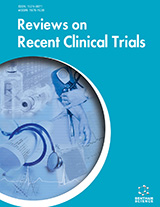Abstract
Glioblastoma, the most highly aggressive and lethal form of brain cancer, has been a particular challenge to treat in terms of improving a patients quality of life and outcome. Each of the current treatment options is limited due to factors intrinsic to the tumors biology and the special microenvironment of its location within the brain. Surgical resection is limited by the non-circumscribed borders that can be detected. Radiation therapy has to contend with neurotoxicity to adjacent normal tissues. Chemotherapy is constrained by the blood-brain barrier, which is a very real constraint of systemic therapy - producing minimal benefit with substantial toxicity in order to administer therapeutic dosages. In part, such hurdles explain the reasons why survival has changed little over many decades of research in this field. The newest generation of treatments includes more effective cytotoxic agents, so-called targeted compounds, and biologics/immunotherapeutics. This article summarizes the preclinical proof-of-concept research and human studies involving some of the agents creating the most positive buzz in the medical community. The advantages and limitations of each are described.
Keywords: Glioma, Cancer, Chemotherapy, Radiotherapy, Vaccine, Antibody
Reviews on Recent Clinical Trials
Title: Current Status of Clinical Trials for Glioblastoma
Volume: 1 Issue: 3
Author(s): Michael L. Salgaller and Linda M. Liau
Affiliation:
Keywords: Glioma, Cancer, Chemotherapy, Radiotherapy, Vaccine, Antibody
Abstract: Glioblastoma, the most highly aggressive and lethal form of brain cancer, has been a particular challenge to treat in terms of improving a patients quality of life and outcome. Each of the current treatment options is limited due to factors intrinsic to the tumors biology and the special microenvironment of its location within the brain. Surgical resection is limited by the non-circumscribed borders that can be detected. Radiation therapy has to contend with neurotoxicity to adjacent normal tissues. Chemotherapy is constrained by the blood-brain barrier, which is a very real constraint of systemic therapy - producing minimal benefit with substantial toxicity in order to administer therapeutic dosages. In part, such hurdles explain the reasons why survival has changed little over many decades of research in this field. The newest generation of treatments includes more effective cytotoxic agents, so-called targeted compounds, and biologics/immunotherapeutics. This article summarizes the preclinical proof-of-concept research and human studies involving some of the agents creating the most positive buzz in the medical community. The advantages and limitations of each are described.
Export Options
About this article
Cite this article as:
Salgaller L. Michael and Liau M. Linda, Current Status of Clinical Trials for Glioblastoma, Reviews on Recent Clinical Trials 2006; 1 (3) . https://dx.doi.org/10.2174/157488706778250140
| DOI https://dx.doi.org/10.2174/157488706778250140 |
Print ISSN 1574-8871 |
| Publisher Name Bentham Science Publisher |
Online ISSN 1876-1038 |
 4
4
- Author Guidelines
- Bentham Author Support Services (BASS)
- Graphical Abstracts
- Fabricating and Stating False Information
- Research Misconduct
- Post Publication Discussions and Corrections
- Publishing Ethics and Rectitude
- Increase Visibility of Your Article
- Archiving Policies
- Peer Review Workflow
- Order Your Article Before Print
- Promote Your Article
- Manuscript Transfer Facility
- Editorial Policies
- Allegations from Whistleblowers
Related Articles
-
Endocytosis, Intracellular Traffic and Fate of Cell Penetrating Peptide Based Conjugates and Nanoparticles
Current Pharmaceutical Design Targeting the Tumor Proteasome as a Mechanism to Control the Synthesis and Bioactivity of Matrix Macromolecules
Current Molecular Medicine Flavonoid Kaempferol Inhibits the Proliferation and Survival of Human Leukemia HL60 Cells
Current Drug Therapy Clinical Applications of Choline PET/CT in Brain Tumors
Current Pharmaceutical Design Annexins in the Central Nervous System: Are they Neuroprotective or Proapoptotic Agents?
Medicinal Chemistry Reviews - Online (Discontinued) Triterpenoids for Cancer Prevention and Treatment: Current Status and Future Prospects
Current Pharmaceutical Biotechnology Tumor-Associated Macrophages as Potential Targets for Anti-Cancer Activity of Marine Invertebrate-Derived Compounds
Current Pharmaceutical Design Small Molecules Targeting Mutant P53: A Promising Approach for Cancer Treatment
Current Medicinal Chemistry Targeting PPARalpha in Alzheimer's Disease
Current Alzheimer Research Endothelial Cell Heterogeneity: A Developmental Biologist’s Perspective
Current Angiogenesis (Discontinued) The Interactions of the 5-HT3 Receptor with Quipazine-Like Arylpiperazine Ligands. The Journey Track at the End of the First Decade of the Third Millennium
Current Topics in Medicinal Chemistry Analytical Approaches for Assaying Metallodrugs in Biological Samples: Recent Methodological Developments and Future Trends
Current Drug Metabolism RING-, HECT-, and RBR-type E3 Ubiquitin Ligases: Involvement in Human Cancer
Current Cancer Drug Targets Cyclophilin A as a Target of Cisplatin Chemosensitizers
Current Cancer Drug Targets PET Imaging to Monitor Cancer Therapy
Current Pharmaceutical Biotechnology Combinatorial Application of Nucleic Acid-Based Agents Targeting Protein Kinases for Cancer Treatment
Current Pharmaceutical Design Analogs of Cinnamic Acid Benzyl Amide As Nonclassical Inhibitors of Activated JAK2 Kinase
Current Cancer Drug Targets New Targets for the Modulation of Radiation Response - Selective Inhibition of the Enzyme Cyclooxygenase 2
Current Medicinal Chemistry - Anti-Cancer Agents Cyclooxygenases in the Central Nervous System: Implications for Treatment of Neurological Disorders
Current Pharmaceutical Design Nuclear Imaging of Inflammation in Neurologic and Psychiatric Disorders
Current Clinical Pharmacology


























